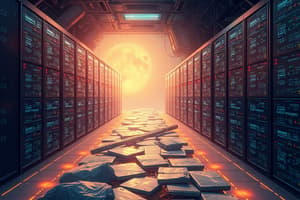Podcast
Questions and Answers
What are the three main principles of the CIA Triad?
What are the three main principles of the CIA Triad?
- Confidentiality, Integrity, Availability (correct)
- Control, Integrity, Application
- Capacity, Integrity, Availability
- Confidentiality, Information, Authorization
Which of the following is NOT a method for authentication?
Which of the following is NOT a method for authentication?
- Tokens
- Passwords
- Risk Management (correct)
- Biometrics
What is a vulnerability in cybersecurity?
What is a vulnerability in cybersecurity?
A weakness in a system that can be exploited by a threat actor to perform unauthorized actions.
Which of the following is NOT a type of cyber threat?
Which of the following is NOT a type of cyber threat?
What is the most common method for combating malware?
What is the most common method for combating malware?
Which of the following is a best practice for cybersecurity?
Which of the following is a best practice for cybersecurity?
HIPAA is a US law designed to protect sensitive health information.
HIPAA is a US law designed to protect sensitive health information.
A set of security standards designed to ensure that all companies that accept, process, store, or transmit credit card information maintain a secure environment is known as ISO/IEC 27001.
A set of security standards designed to ensure that all companies that accept, process, store, or transmit credit card information maintain a secure environment is known as ISO/IEC 27001.
What are the two main types of AI used to detect and respond to cyber threats?
What are the two main types of AI used to detect and respond to cyber threats?
What are the challenges involved in securing the Internet of Things (IoT) devices?
What are the challenges involved in securing the Internet of Things (IoT) devices?
What is the primary advantage of blockchain technology for cybersecurity?
What is the primary advantage of blockchain technology for cybersecurity?
What does digital forensics involve?
What does digital forensics involve?
What is the primary goal of the digital forensic process?
What is the primary goal of the digital forensic process?
Which of the following is NOT a type of digital forensics?
Which of the following is NOT a type of digital forensics?
Which of the following is considered a legal and ethical consideration in digital forensics?
Which of the following is considered a legal and ethical consideration in digital forensics?
Digital forensics is not facing any significant challenges due to its rapid advancements.
Digital forensics is not facing any significant challenges due to its rapid advancements.
What is GRC in the context of IT?
What is GRC in the context of IT?
The primary goal of Governance, Risk, and Compliance (GRC) is to improve operational efficiency and enhance decision-making.
The primary goal of Governance, Risk, and Compliance (GRC) is to improve operational efficiency and enhance decision-making.
What are the four main components of GRC?
What are the four main components of GRC?
What is a network?
What is a network?
What are the key advantages of using a network?
What are the key advantages of using a network?
Which of the following is NOT a type of network?
Which of the following is NOT a type of network?
Which of the following is a key networking device?
Which of the following is a key networking device?
A ______ is a basic networking device that connects multiple Ethernet devices, making them act as a single broadcast segment.
A ______ is a basic networking device that connects multiple Ethernet devices, making them act as a single broadcast segment.
Which of the following is NOT a network topology?
Which of the following is NOT a network topology?
A mesh topology offers high reliability due to its multiple paths between devices.
A mesh topology offers high reliability due to its multiple paths between devices.
What is the primary function of the Transport Layer in the TCP/IP model?
What is the primary function of the Transport Layer in the TCP/IP model?
Flashcards
String
String
A data type that represents a sequence of characters. It's used to store text, like words, sentences, or paragraphs.
Software Release
Software Release
The process of creating a new version of a software application with improved features, bug fixes, and enhancements.
Computer Program
Computer Program
A set of instructions that a computer can understand and execute.
Algorithm
Algorithm
Signup and view all the flashcards
Syntax
Syntax
Signup and view all the flashcards
Semantics
Semantics
Signup and view all the flashcards
Programming Environment
Programming Environment
Signup and view all the flashcards
Protocol
Protocol
Signup and view all the flashcards
Dataset
Dataset
Signup and view all the flashcards
Debugging
Debugging
Signup and view all the flashcards
Study Notes
Basics of Information Technology
- Information Technology (IT) is a broad term encompassing technology use to manage and process information
- Key functions include data storage, retrieval, transmission, and manipulation
Data Storage
- Methods and devices used for data preservation and future access
- Hard Drives: Traditional magnetic storage
- Solid-State Drives (SSDs): Flash memory, faster and more reliable than hard drives
- Cloud Storage: Remote servers accessed via the internet
- Databases: Organized data collections
Data Retrieval
- Techniques and technologies for efficient data access
- Search Algorithms: Used to find specific data in large datasets (e.g., binary search, hash tables, search engines)
- Query Languages: Languages like SQL for interacting with databases and retrieving data
- Indexing: Speeding up retrieval by creating indexes
- Caching: Storing frequently accessed data to reduce retrieval times
Data Transmission
- Communication systems and protocols to transfer data between systems.
- Networking: Infrastructure for device communication (e.g., LANs, WANs, the internet)
- Communication Protocols: Rules for data exchange (e.g., TCP/IP, HTTP, FTP)
- Encryption: Techniques for securing data during transmission.
Data Manipulation
- Software and algorithms used to modify data for insights and decision-making.
- Data Processing: Converting raw data into usable formats
- Data Analysis: Techniques like statistical analysis, machine learning, data mining
- Data Visualization: Creating graphical data representations
Database Management Systems (DBMS)
- Software systems for database creation, management and use.
- Examples include MySQL, PostgreSQL, Oracle, and MongoDB.
History of IT
- Abacus: One of the earliest known computing tools
- Mechanical Calculators: Early mechanical calculators (e.g., Pascaline, Leibniz Wheel)
- Analytical Engine: Mechanical general-purpose computer concept by Charles Babbage
- Digital Computers: ENIAC, early electronic general-purpose digital computers
- Mainframe Computers: Powerful computers used mainly for large transactions
Importance of IT in Business
- Efficiency: Automation of routine tasks (e.g., data entry, inventory)
- Productivity: Streamlining communication and coordination
- Decision Making: Using data analysis tools for insights and strategic planning
- Innovation: Enabling product development, digital transformation, and customer engagement
- Cost Reduction: Optimized workflows and resource management
Components of IT Systems
-
Hardware: Physical components
-
Computers, Servers, Storage Devices (HDDs, SSDs, NAS), Networking Equipment (routers, switches, modems), Peripheral Devices.
-
Software: Programs running on the hardware.
-
Operating Systems (e.g., Windows, macOS, Linux), Productivity Software (e.g., Microsoft Office), Specialized Applications, And Development Tools
-
Data: Raw facts and figures to be managed and processed
-
Big data (large, complex datasets), Big Data analysis techniques
-
Human Resources: Skilled professionals
-
IT Managers, Developers, Network Administrators, Support Staff, IT Data Scientists and Analysts
IT Applications
- Healthcare: EHRs, Telemedicine
- Finance: Online banking, fraud detection, financial analysis
- Retail: Ecommerce, Inventory Management
- Education: E-learning platforms, assessment tools
- Manufacturing: Supply chain management, production planning
Networking Devices and Types of Networks
- Router: Connects different networks and manages packet flow
- Switch: Connects devices within a network and forwards data based on MAC addresses
- Hub: Basic networking devices that broadcast data to all connected devices
- Modem: Converts digital to analog signals
- LAN: Connects devices in limited area,
- WAN: Connects devices across large distances
- MAN: Connects devices in a metropolitan area
- PAN: Connects devices for person-centered use
- CAN: Connects devices in a campus area
Operating Systems Overview
- Windows: Widely used, graphical user interface, supports several hardware and software devices.
- macOS: Sleek design, robust performance, integrated with other Apple products
- Linux: Open-source kernel, highly customizable
- Mobile OS: Optimized for mobile devices (e.g., Android, iOS).
IPv4 Addressing Schemes
- Numeric system used for computer networks
- Decimal and binary representations
- Network and host portions of an IP address
Networking Protocols
- TCP/IP: Foundation for internet and most local networks, including TCP, UDP, IP and related tools
- HTTP: Used for transmitting web pages
- FTP: Used for transferring files
Networking Topologies
- Star: Devices connected to a central hub
- Bus: Devices share a single communication line
- Ring: Devices connected in a circular path
- Mesh: Devices are interconnected with direct links
Cybersecurity Fundamentals
- Prevention and protection of systems from digital attacks
- Key concepts: CIA Triad, Authentication, Non-repudiation
- Types of threats: malware, phishing, DoS / DDoS, MitM Attacks
- Defense mechanisms: firewalls, antivirus software, intrusion detection systems (IDS)
Best Practices for Cybersecurity
- Regular updates, strong passwords, data backup, network segmentation, and user training are vital
- Network security is important by protecting the infrastructure from harmful activities
Digital Forensics
- Process of identifying and presenting legally acceptable digital evidence
- Steps: Identification, Preservation, Collection, Examination, Analysis, and Presentation
- Applications: criminal cases, investigations, data breaches.
- Techniques and tools for all forms of digital forensics.
Governance, Risk, and Compliance (GRC)
- Framework of rules supporting ethical business, compliance, and risk mitigation
- Governance: setting strategic goals & accountability
- Risk management: identifying, assessing & controlling threats
- Compliance: adherence to rules, standards, laws
- Components: Governance, Risk Management, and Compliance.
Studying That Suits You
Use AI to generate personalized quizzes and flashcards to suit your learning preferences.



